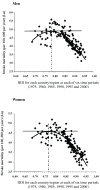Worldwide socioeconomic status and stroke mortality: an ecological study
- PMID: 23767844
- PMCID: PMC3695775
- DOI: 10.1186/1475-9276-12-42
Worldwide socioeconomic status and stroke mortality: an ecological study
Abstract
Introduction: The effect of socioeconomic status (SES) on stroke mortality at population level has been controversial. This study explores the association of SES in childhood and adulthood with stroke mortality, as well as variations in this association among countries/regions.
Methods: Sex-specific stroke mortality at country level with death registry covering ≥ 70% population was obtained from the World Health Organization. Human Development Index (HDI) developed by the United Nations was chosen as the SES indicator. The associations between the latest available stroke mortality with HDI in 1999 (adulthood SES) and with HDI in 1960 (childhood SES) for the group aged 45-54 years among countries were examined with regression analysis. Age-standardized stroke mortality and HDI during 1974-2001 were used to estimate the association by time point.
Results: The population data were available mostly for low-middle to high income countries. HDI in 1960 and 1999 were both inversely associated with stroke mortality in the group aged 45-54 years in 39 countries/regions. HDI in 1960 accounted for 37% of variance of stroke mortality among countries/regions; HDI in 1999 for 35% in men and 53% in women (P < 0.001). There was a quadratic relationship between age-standardized stroke mortality and HDI for the countries from 1974 to 2001: the association was positive when HDI < 0.77 but it became negative when HDI > 0.80.
Conclusions: SES is a strong predictor of stroke mortality at country level. Stroke mortality increased with improvement of SES in less developed countries/region, while it decreased with advancing SES in more developed areas.
Figures


References
-
- World Health Organization. World health report 2004-changing history. Geneva: World Health Organization; 2004.
-
- World Health Organization. Neglected global epidemics: three growing threats. Geneva: World Health Organization; 2004.
-
- Murray CJL, Lopez AD. Global Health Statistics: A Compendium of Incidence, Prevalence, and Mortality Estimates for Over 200 Conditions. USA: The harvard school of public health on behalf of the world health organization and the world bank; 1996.
-
- World Health Organization. Global NCD infobase/online tool. Geneva: World Health Organization; 2008. http://www.who.int/ncd_surveillance/infobase/en. Accessed 10/10.
MeSH terms
LinkOut - more resources
Full Text Sources
Other Literature Sources
Medical

